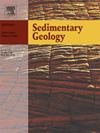Holocene seismically induced soft-sediment deformation structures in the Qingshuihe Basin, northeastern Tibetan Plateau
IF 2.9
2区 地球科学
Q1 GEOLOGY
引用次数: 0
Abstract
This study focuses on the extensive development of soft-sediment deformation structures (SSDS) within the Holocene fluvial-lacustrine strata in the central and southern Qingshuihe Basin, located on the northeastern margin of the Tibetan Plateau. Through basin-wide sedimentological analysis, the study systematically examines the development characteristics, formation mechanisms, and triggering factors of SSDS across various sedimentary facies, while also exploring their relationship with regional seismic events.
The results reveal that a wide variety of SSDS are present in the basin, including small-scale faults, pseudofaults, load structures, water-escape structures, clastic dikes, deformed laminations, tension veins, and mixed accumulations. Most SSDS occur alongside syn-sedimentary faults (small-scale faults or pseudofaults) and exhibit significant directional features. SSDS in fluvial facies are more prominent than those in lacustrine facies, with the former displaying clear stratification, while the latter shows multi-phase deformation. Both fluvial and lacustrine SSDS are closely correlated in stratigraphic position and formation age with tension veins observed in loess deposits on the western side of the basin. Furthermore, the intensity of deformation exhibits a significant negative correlation with the distance from boundary faults. Most SSDS display characteristics of liquefaction, fluidization, and brittle deformation, consistent with seismic shaking.
Radiocarbon dating of 35 samples and optically stimulated luminescence (OSL) dating of 7 samples indicate that the SSDS in the southern part of the basin (6220 ± 95 a BP to 717 ± 24 a BP) are strongly associated with three major seismic events along the Haiyuan-Liupan Mountain Fault (a paleo-earthquake from 6600 ± 500 a BP to 5640 ± 540 a BP, the 1219 Guyuan M7 earthquake, and the 1306 Guyuan M7 earthquake). Meanwhile, SSDS in the central basin (11,270 ± 1100 a BP to 7728 ± 36 a BP) likely reflect three significant seismic events along the southeastern segment of the Xiangshan-Tianjingshan fault (XS-TJSF). These earthquakes are estimated to have magnitudes ranging from 6.5 to 7.3, with epicenters located in the central region of the southeastern segment of the XS-TJSF.
This study refines the criteria for identifying earthquake-induced SSDS and provides critical evidence for reconstructing the regional paleo-seismic history, thereby enhancing the understanding of the complex tectonic activity in the area.
青藏高原东北部清水河盆地全新世地震诱发软沉积变形构造
本文研究了青藏高原东北缘清水河盆地中南部全新世河湖地层中广泛发育的软沉积变形构造(SSDS)。通过全盆地的沉积学分析,系统探讨了不同沉积相下SSDS的发育特征、形成机制、触发因素,并探讨了其与区域地震事件的关系。研究结果表明,盆地内存在多种类型的断裂构造,包括小尺度断裂、假断裂、负荷构造、泄水构造、碎屑岩脉、变形层状、张拉脉和混合堆积等。大多数SSDS发生在同沉积断层(小断层或假断层)附近,并具有明显的方向性特征。河流相的SSDS比湖相的SSDS更为突出,河流相的SSDS表现为明显的分层作用,而湖相的SSDS表现为多期变形。盆地西侧黄土沉积中所发现的张拉脉与河流和湖泊的SSDS在地层位置和形成年代上具有密切的相关性。变形强度与离边界断层的距离呈显著负相关。大多数固态岩石表现出液化、流态化和脆性变形的特征,与地震震动相一致。35个样品的放射性碳定年和7个样品的光学激发发光(OSL)定年表明,盆地南部(6220±95 a BP ~ 717±24 a BP)的SSDS与海原-六盘山断裂带的3次大地震(6600±500 a BP ~ 5640±540 a BP的古地震、1219年固原7级地震和1306年固原7级地震)密切相关。同时,盆地中部(11,270±1100 a BP ~ 7728±36 a BP)的SSDS可能反映了香山-天景山断裂东南段(ks - tsf)的3次重大地震事件。据估计,这些地震的震级在6.5到7.3级之间,震中位于xs - tsf东南段的中部地区。该研究完善了地震诱发SSDS的识别标准,为重建区域古地震历史提供了重要依据,从而增强了对该区复杂构造活动的认识。
本文章由计算机程序翻译,如有差异,请以英文原文为准。
求助全文
约1分钟内获得全文
求助全文
来源期刊

Sedimentary Geology
地学-地质学
CiteScore
5.10
自引率
7.10%
发文量
133
审稿时长
32 days
期刊介绍:
Sedimentary Geology is a journal that rapidly publishes high quality, original research and review papers that cover all aspects of sediments and sedimentary rocks at all spatial and temporal scales. Submitted papers must make a significant contribution to the field of study and must place the research in a broad context, so that it is of interest to the diverse, international readership of the journal. Papers that are largely descriptive in nature, of limited scope or local geographical significance, or based on limited data will not be considered for publication.
 求助内容:
求助内容: 应助结果提醒方式:
应助结果提醒方式:


